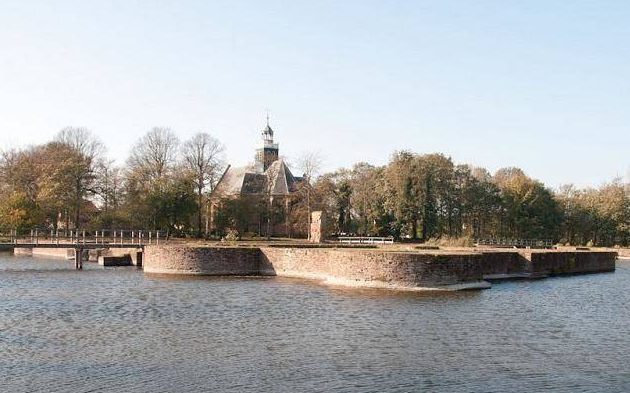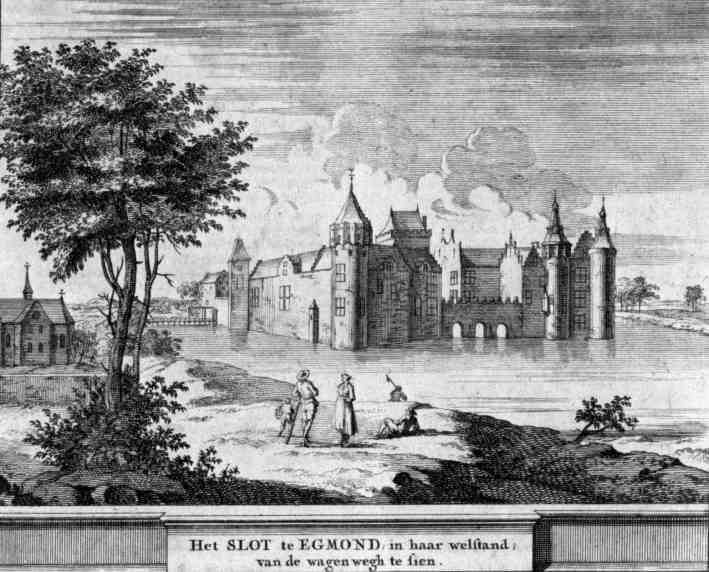Here stood the largest castle in Holland
Very beautiful is the castle quarter also when there is snow and preferably ice. Then there will be ice skating on the Slotgracht and ‘koek and zopie’
The Castle Quarter
The Slotkwartier is the old center of Egmond aan den Hoef. This is a beautiful historic area, surrounded by the Castle Park, where you can take a short walk. It is good to relax on the lawn between the bricked-up foundations of the Slot op den Hoef, with views of the historic Overslot and lots of greenery in the summer. Many a biking or hiking group holds a picnic here.
Statue for headless count
Actually, it is strange that his statue has not even been there that long. Lamoraal, the fourth and most famous Count of Egmond to be beheaded at Brussels in 1568. Goethe poems about this drama and Beethoven writes music to it such as the Overture Egmond. Five years after the execution, the castle is destroyed by Sonoy’s Beggars so that the hated papist Spaniards cannot settle in it.
Seated on a bench near the statue, you can read some information. If you look toward Alkmaar, you will see one of the oldest polders.
The swamp was drained at that time by order of the same Lamoraal. However, we must honestly admit that Lamoral had too many possessions to stay here often.


The foundations containing a piece of the ruined wall of the Rentmeesters Tower are accessible free of charge. From this, the layout of the castle can still be easily recognized such as the castle towers and the slots of the counterweights of the two drawbridges.
There is an old well and the rectangular courtyard is also easy to see. What you don’t see is how huge the castle was. For example, the largest residential tower the Donjon was no less than 28 meters high, the same height as the Sterflat, the tallest building in Egmond aan Zee. The Donjon had 7 floors but then again, each was a bit higher than the ten floors of the Starflat.
Holland’s largest and “cleanest” castle stood here, and exactly what it looked like, no one knows for sure. Visitors can let their imagination run wild here. Here the tower keeper sounded his horn for the illustrious castle residents and their visitors. Here hoof-beating sounded and medieval village life played out.
Excavations in the 1930s
As part of the relief work, the foundations were uncovered and rebuilt in 1933/1934, under the direction of engineer Johannes van Oldenborgh.
A summary in words and pictures of his report is at www.historischegmond.nl. There you will find more about the history and also the slot in 3D.


Amazing history
Those who read more about this lock’s illustrious past fall from one surprise to another. For example, many Egmonders have the book Derper-Hoever-Binder on their bookshelves, written in 1978 by Kathinka Lannoy and Bob Denneboom. It is for many the still very readable “bible” of Egmond history. That we still know so much is due to the fact that the monks of the abbey were able to bring a large number of documents to safety before the destruction.
Thus Father Jan Hof was able to use it to reconstruct the history of the abbey from 922 to 1573, and the castle appears frequently in it. In 2008, the beautiful book “The Castle of Egmond” by Arnold C.M. Burger was republished by Pirola Publishers in Schoorl. This pleasantly written book full of illustrations explains the origins of the castle. Burger emphasizes how immense the castle once was and the fact that we don’t know exactly what it looked like.

